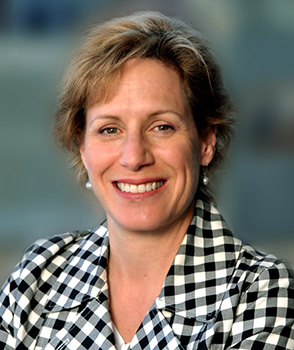With the Super Bowl coming to the Bay Area next month, many ferry riders may be concerned about disruptions in their commute. Security is bound to be top of mind that weekend, and you can expect a heightened level of vigilance on the waterfront.

Sidonie Sansom is the Port of San Francisco’s director of homeland security.
By Patrick Burnson
Published: January, 2016
With the Super Bowl coming to the Bay Area next month, many ferry riders may be concerned about disruptions in their commute. Security is bound to be top of mind that weekend, and you can expect a heightened level of vigilance on the waterfront.
Fortunately, the Port of San Francisco has a proven leader in place to deal with this challenge. Sidonie Sansom, who joined the port as director of homeland security in July 2005, recently told Bay Crossings that existing protocols and partnerships will keep commerce humming throughout the duration of this annual sporting spectacle.
“We work in close conjunction with Oakland and the other ports in the Bay Area to ensure that both cargo and passenger traffic moves efficiently under any and all circumstances,” Sansom said. “It’s definitely a regional effort where security is concerned.”
Sansom is charged with developing, directing and implementing a comprehensive homeland security program for the port, and is also responsible for the port’s emergency plans and procedures—both in preparation for and in response to emergencies and disasters.
“The port’s security programs, as well as the emergency preparedness and response plans, are intended to create a safer and more secure environment for our employees, tenants, customers and the public, all of whom use the 7.5 miles of waterfront property we manage,” Sansom said.
Sansom has more than 10 years of experience in developing and leading integrated operations in emergency preparedness. “But it’s a continuing learning process,” she said. “We last put the Bay on high alert when the London bombings occurred, and we managed that process very well.”
That terrorist attack—which targeted London commuters just a month after Sansom began her job here in summer 2005—was a test that all stakeholders managed to see through. “Unlike many working ports, San Francisco must provide waterfront access to the public,” said Sansome. “It’s part of our mandate.”
Before joining the port, Sansom served as an emergency planner at the San Francisco International Airport, where she developed exercises to test emergency response and emergent threats, as well as cross-jurisdictional, multi-agency response procedures for the airport’s water perimeter security zone.
“There are many similar issues for air and sea ports,” Sansom said. “Both are international gateways for passengers and cargo and have complicated logistical networks.”
Largest-Ever Containership to Visit U.S. Comes to Oakland
The largest containership ever to visit the United States steamed into the Bay to call the Port of Oakland on the final day of 2015. The 1,300-foot-long Benjamin Franklin made a one-day stop on its maiden voyage. According to port authorities, its arrival could forever change the nature of trade between the United States and Asia.
“Nothing this big has ever been seen in our country,” said Port of Oakland Executive Director Chris Lytle. “There’s no doubt others will follow suit and we’re gratified that Oakland is one of the only ports in the United States ready to receive them.”
The Franklin, operated by Marseille-based shipping line CMA CGM, is the world’s 10th largest containership. It was launched from a Chinese shipyard last month. CMA CGM said it will deploy the vessel on a regularly scheduled service between California, China and South Korea. The Franklin’s first visit to Oakland is considered a trial run, as officials want to ensure that the vessel can be berthed and its cargo discharged efficiently.
The Franklin is known in industry lingo as a “megaship” or “ultra large container carrier.” It can hold up to 18,000 20-foot shipping containers. The largest ships currently serving this country carry 14,000 containers.
Oakland is one of a handful of U.S. ports that can receive such megaships, as most other ports lack sufficient water depth for the deep-draft vessels. Gulf and East Coast ports are further limited by the Panama Canal. Even though the canal is expanding, it won’t be big enough to accommodate the ocean-going giants from Asia.
Oakland has invested millions in recent years to prepare for big ships. The steps have included: dredging berths and channels to 50-foot depths; raising the height of cranes that load and unload vessels; and modernizing marine terminals to handle increased import and export volumes.
Until now, vessels the size of the Benjamin Franklin have been deployed exclusively in the Asia-Europe trade as it is the world’s busiest container shipping route. But ocean carriers are eager to extend the reach of megaships to the Trans-Pacific lane. That’s because bigger ships provide economies of scale. Since they’re newer, they also burn less fuel and produce fewer exhaust emissions than older vessels.
Patrick Burnson is the past president and current board member of the Pacific Transportation Association, based in San Francisco. www.pacifictrans.org

